



Canada - Livestock and Products Semi-Annual Report 2010
Canada’s cattle and swine herds are forecast to continue on a downward trend, according to the latest GAIN Report from USDA Foreign Agricultural Service.Report Highlights
Canada’s cattle and swine herds are forecast to continue on a downward trend with the ongoing increased strength of the Canadian dollar dampening export potential. The beef cattle herd dropped to 11 million head, down 1.4 per cent with current indications that a moderate expansion may begin in 2011 or 2012. The swine herd is pegged at 11.6 million head, down another 4.5 per cent from the year before. A further decline to about 12.7 million head is forecast by the end of 2010 in part aided by the C$75 million Hog Farm Transition Programme. The aim of the programme is to reduce the herd by the equivalent of 250,000 sows (1.3 million in inventory January 2010) via payments requiring vacating production facilities for three years. Canada’s cattle exports totaled 1.067 million head in 2009, down from 1.6 million head in 2008. The cattle export forecast for 2010 is 1.15 million head. Total 2009 beef imports, up 7 per cent to 247,032 mt are expected to climb further to 290,000 mt in 2010. Canadian beef exports fell 3 per cent in 2009 to 480,294 mt due to drop in shipments to the United States and are expected to expand to 490,000 tons in 2010. Exports of hogs totaled almost 6.4 million head in 2009, down from 9.4 million in 2008 with the 2010 forecast pegged at 6.0 million head. After totaling 1.12 mmt in 2009, in 2010 the pork exports are forecast up slightly to 1.13 mmt.
Executive Summary
- The Canadian beef cattle herd dropped to 11 million head, down 1.4 per cent and the lowest in 15 years as of January 2010. Current indications are that a moderate expansion may begin in 2011 or 2012.
- Canada’s cattle exports totaled 1.067 million head in 2009, down 33 per cent from the 1.6 million head exported in 2008. The forecast for 2010 is 1.15 million head, up slightly reflecting tightened supply in the United States as well as some stability, if not softening, in the value of the Canadian dollar.
- Total 2009 beef imports, up 7 per cent to 247, 032 mt, did reflect the recessionary demand for an increase in lower priced cuts from New Zealand, Australia and Uruguay and increased buying power of the stronger Canadian dollar. Some rebound in the economy is expected to spur increased beef imports to 290,000 mt in 2010.
- Canadian beef exports fell 3 per cent in 2009 to 480,294 mt due to drop in shipments to the United States. Although world demand is still recovering and fluctuations in the value of the Canadian dollar are negative strains on exports, overall exports are expected to expand to 490,000 tons in 2010.
- As of January 2010, the swine herd is pegged at 11.6 million head, the lowest in 12 years and down 4.5 per cent from the year before. A further decline to about 12.7 million head is forecast by the end of 2010.
- Exports of hogs totaled almost 6.4 million head in 2009, down 32 per cent from 2008. The largest decline was in slaughter animals, totaling 1.1 million head compared to 2.3 million head in 2008. Due to the continued strong Canadian dollar the forecast for 2010 is 6.0 million head.
- After totaling 1.12 mmt in 2009, 2010 the pork export are forecast up slightly to 1.13 mmt reflecting the reopening of the Chinese market as well as overall expectations that world wide pork consumption will trend upward as recessionary pressures soften and consumers look for lower priced meats.
- Details of the C$75 million Hog Farm Transition Programme (HFTP) were announced in December 2009 with the first three (of four) tranches resulting in a total reduction of 671,250 head of which 105,358 are sows. The aim of the programme is to reduce the herd by the equivalent of 250,000 sows. The highest proportional reductions are in the small producing provinces of British Columbia and the Atlantic region. The largest reduction, Ontario, represents about 3.6 per cent of the provinces total 2009 production. The last tranche is in March 2010. These payments require vacating production facilities for three years.
Production
Cattle and Beef
The Statistics Canada yearend livestock report adjusted some cattle numbers in 2008 (slight drop in calf production) as well as in 2009. The cattle herd is pegged at just over 13 million head, larger by about 300,000 head than had earlier been forecast but the lowest in 15 years. Between 1 January 2009 and 1 January 2010, the beef herd dropped to 11 million head, down 1.4 per cent while the dairy herd remained about flat (0.2 per cent decline) at about 1.97 million head. Reductions in the herds in Alberta, Manitoba, British Columbia, Quebec and the Atlantic provinces totaled more than the increases in Saskatchewan and Ontario.
Based on the new data, the calf crop forecast for 2010 have been adjusted down to 4.98 million head compared to 5.05 million at the last forecast with ending inventories pegged at 12.7 million head compared to the earlier forecast of 12.5 million head. The retraction of the herd size has slowed, about 1.2 per cent decline since January 2009, but the number of breeding heifers continued to decline, a total of almost 4 per cent for the year. Some late-year 2009 strengthening of heifer prices and some reprieve from constant feed price increases are improving the outlook for producers. However, concerns about continued drought conditions and feed quality in 2010 as well as the continued strong (but at least more stable) Canadian dollar are working against herd expansion. Current indications are that a moderate expansion may begin in 2011 or 2012. A stronger world wide rebound is consumer demand and exports may pull the process along faster.
Statistics Canada indicated that 2009 total slaughter reached almost 3.7 million head, down about 175,000 head from the pervious estimate. Early data show slaughter down about 4 per cent in the first six weeks of 2010. The total slaughter forecast for 2010 is adjusted from 3.7 million head to 3.62 million head although if export demand for beef picks up, the slaughter forecast may be on the low side.
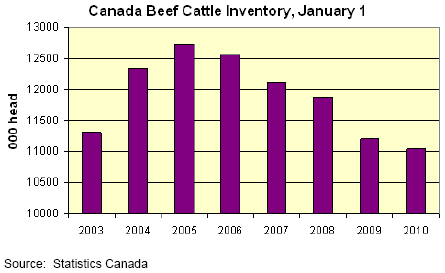
Cattle Market Prices
Despite tighter supplies the fed steer prices in Canada have continued on a downward trend throughout 2009 and early into 2010 but tightening supplies in the United States may result in some upward movement in 2010. Bred heifer prices rallied moderately in late 2009 but the increases have not been sustained. Cattle producers continue to voice concern about the price-dampening effect of continued packer concentration and on the cost of disposing of specified risk materials (SRM) in the continued aftermath of the 16 detections of bovine spongiform encephalopathy (BSE) which began in 2003. The producers argue that the stricter Canadian requirements cost them about $25 more per head than the disposal requirements in the United States.
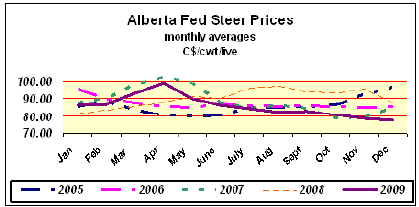

Consumption
Beef and Veal
Domestic per-capita beef consumption is expected to stabilise and show signs of expansion by late 2010 prompted by the economic recovery and soft prices. The total 2010 consumption forecast is revised 10 1.015 mmt to reflect new data for earlier years. Although total meat consumption has declined with the recession, beef has been the favored red-meat for consumption given some effect of H1N1 on consumer perceptions of pork although lower pork prices coupled with shoppers seeking increased value puts downward pressure on beef prices. Total CY 2009 consumption is estimated to have declined to about 30 kilograms carcass weight basis per capita.
Trade
Cattle Trade
Canada’s cattle exports totaled 1.067 million head in 2009, down 33 per cent from the 1.6 milion head exported in 2008. Factors attributed to this decline include the strengthening of the Canadian dollar, the shift in the recession market in the United States toward lowest priced cuts, and some uncertainty surrounding requirements under the Country of Origin Labeling (COOL) regulations. The forecast for 2010 remains unchanged at 1.15 million head, up slightly from 2009 reflecting tightened supply in the United States as well as some stability if not softening of the value of the Canadian dollar. Need to fill US feedlots may also push the numbers up later in the year. Canadian cattle import forecast is reduced to 50,000 head in 2010, or about the same as the 2009 imports of 54,000 head.
Beef and Veal Imports
Recent data show imports of beef and veal increased in 2009 by about 7 per cent despite some decreased demand, at least on the high end, primarily US trade, due to the recession. Beginning in March 2009 the Canadian dollar strengthened which made the imported beef more affordable. Beef imports did reflect the recessionary demand for an increase in lower priced cuts from New Zealand, Australia and Uruguay. Rebounding of the economy is expected to spur increased beef imports with the 2010 forecast at 290,000 mt. This forecast is unchanged.
Canada operates a tariff rate quota (TRQ) on beef but it does not apply to imports from the United States, Mexico, and Chile under free trade agreement provisions. The global minimum access commitment for beef and veal is 76,409 MT within which there are two country-specific reserves: 29,600 MT reserved for imports from New Zealand and 35,000 MT reserved for imports from Australia. The balance of the TRQ, 11,809 MT (known as the MFN reserve), is reserved for imports from all other eligible suppliers, including those from New Zealand and Australia once their country-specific allocations are filled. Beef imported in excess of the minimum access commitment incur the higher “over access commitment” rate of 26.5 per cent. For the purpose of administering the beef and veal TRQ, the quota year is the calendar year. Following the detection of BSE in Alberta in 2003, the Government of Canada moved to restrict the issuances of supplementary beef imports from non-NAFTA suppliers because of beef surpluses in Canada. As a result, imports from these suppliers have been lower since that time.
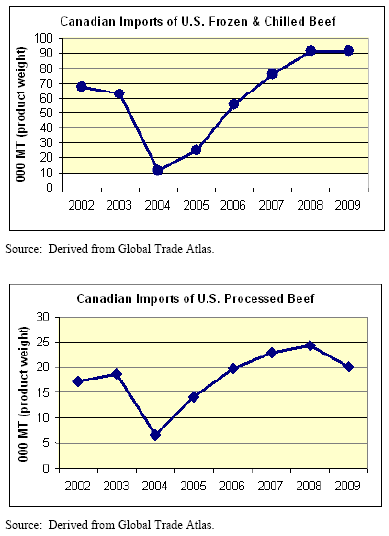
Beef and Veal Exports
Canadian beef exports fell by 3 per cent in 2009 to 480,294 mt due to drop in imports from the United States. However, aggressive efforts by the government to pry open markets closed due to lingering concerns about BSE resulted in increased exports to Hong Kong, Japan, Taiwan and Vietnam. Marketing campaigns by the Canada Beef Export Federation have also expanded in these markets. Although world demand is still recovering and fluctuations in the value of the Canadian dollar are negative strains on exports, overall exports are expected to expand to 490,000 tons in 2010. This forecast is unchanged.
Policy
Canada Launches Two WTO Disputes
In late 2008 Canada and Mexico filed dispute at the World Trade Organization (WTO) on the interim rule of the Country of Origin Labeling (COOL). Consultations were held twice and a new case was filed in May 2009. On 19 November 2009, at the request of Canada and Mexico, the WTO Dispute Settlement Body established a single panel to consider the complaints regarding US mandatory COOL. The process to select panelists is still underway. The substance of Canada and Mexico’s claims remain the same, and include allegations of inconsistency with the General Agreement on Tariffs and Trade 1994 (national treatment and transparency provisions), the Agreement on Technical Barriers to Trade (technical regulations provisions) or in the alternative, the Agreement on the Application of Sanitary and Phytosanitary Measures, and the Agreement on Rules of Origin (Article 2).
In July 2009, Canada requested the establishment of a WTO dispute settlement panel on the issue of South Korea’s continuing ban on the importation of Canadian beef. South Korea has banned Canadian beef since May 2003 after bovine spongiform encephalopathy (BSE) was discovered in an Alberta cow. Before the ban, South Korea was Canada’s fourth-largest beef export market, valued at C$50 million in 2002. In May 2007, the World Organization for Animal Health (OIE) officially categorized Canada as a “Controlled Risk” country for BSE. The WTO panel, which was formed in November 2009, is asked to determine whether South Korea’s continuing ban on Canadian beef is consistent with its international trade obligations under the WTO, specifically several articles of the Sanitary and Phytosanitary Agreement the General Agreements on Tariffs and Trade . It is Canada’s view that South Korea’s continuing ban is a violation of its WTO obligations in that the ban is not based on the relevant international standards or on science, and that it is discriminatory among WTO members and restricts trade more than necessary.
Alberta Ends Non-refundable Check-Offs
Legislation ending non-refundable check-offs will take effect 1 April 2010 in the province of Alberta, home to about 40 per cent of the Canadian cattle herd. Several other provinces already have refundable or partially refundable (national part non-refundable) check-offs (British Columbia, Manitoba, Saskatchewan). The legislation was spurred by come cattle producers who felt their $3/head check off funds were not gleaning results since the detection of the first case of BSE. Also there was tension between the cow-calf operations and the feedlots and whether funds to one organization, the Alberta Beef Producers (ABP) could promote all interests. The change will effect four organizations: Alberta Beef Producers, Alberta Pork, Alberta Lamb Producers and the Potato Growers of Alberta. Several other provinces already have refundable or partially refundable (national part nonrefundable) check-offs (British Columbia, Manitoba, Saskatchewan).
No one is sure what the actual effect of the new refundable system will be on the $12-13 million collected annually by the ABP. For each $3 collected, $1 will still be remitted to the national agency which funds the Beef Information Centre, the Canadian Beef Export Federation (CBEF) and the Beef Cattle Research Council. ABP sends part of the remaining funds to the Canadian Cattlemen’s Association. The ABP has announced that their budgets will be based on the pervious year’s funds but for this transition year they have reduced their budget from $8 million to $5 million. Observers are watching to see how the relatively few feedlot owners react to the new flexibility which could change the size and direction of the ABP.
Production
Swine and Pork
The Statistics Canada yearend livestock report adjusted the pig crop numbers ups slightly in both 2008 and 2009. As of January 2010, the swine herd is pegged at 11.6 million head, larger by about 250,000 head than had earlier been forecast but the lowest in 12 years. The breeding herd showed a further drop of 4.3 per cent. The industry is showing further retraction with the size of the remaining operations increasing in size. The number of hog producers dropped to 7,360 at the end of 2009 with the number of hogs per farm increased from 1,482 to 1,580, or 6.7 per cent, indicating a continued exodus of mixed farms and concentration of managed hog operations.
The production forecast for 2010 is unchanged at 28 million head reflecting continued downsizing in the industry as returns remain below the cost of production and some producers opt to accept the new government buyout programme. The 2009 slaughter total was adjusted according to the Statistics Canada data to 21.8 million head. The 2010 forecast is reduced by 500,000 head to 21.2 million based on the adjusted herd size data.
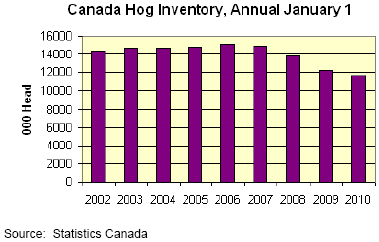
Hog Market Prices
Hog prices continued well below previous years throughout most of 2009 but perked up in December suggesting a strengthening trend in 2010 due to tighter supplies and improving consumer demand for pork as a lower priced meat. Producers continue to face prices below the cost of production with one estimate from Manitoba indicating the margin remains C$13/head below the break even point and C$33/head below the amount needed to cover debt loads.
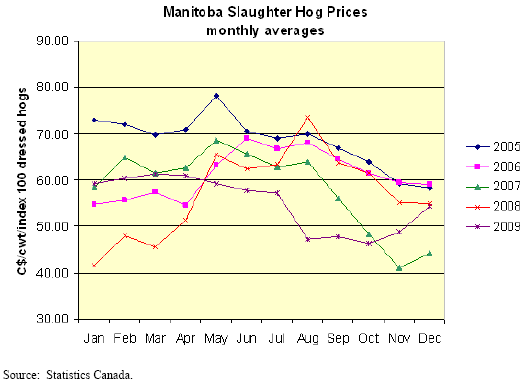

Consumption
Of the three major meats, beef, pork and chicken, over the last decade the share of pork in the Canadian per capita meat consumption is the only one that has decline. In 2000, pork represented 32 per cent of total consumption and by 2008 it had dropped to 28 per cent despite the fact that that other two are generally higher priced (chicken prices benefit from the supply management system). According to Statistic Canada, per capita pork consumption in 2008 declined 4.8 per cent from 2007. The pork industry is battling against consumer perceptions that pork is not easy or fast to prepare and lack of perception that pork is a “healthy” meat. Pork has also made limited inroads in the foodservice market. The expectation is that the 2009 figure will show a further decline, estimated at 22.9 kilograms per person, primarily due to the recession and overall downturn in meat consumption. Uncertainty about the linkage with H1N1 also pushed pork consumption down. With lower prices consumption is forecast to rise slightly in 2010.
Trade
Hog Exports
Total exports of hogs totaled almost 6.4 million head in 2009, up compared to earlier estimates by about 100,000 head, but down 32 per cent from 2008. The largest decline was in slaughter animals, totaling 1.1 million head compared to 2.3 million head in 2008. Due to the continued strong Canadian dollar the forecast for 2010 is pulled down to 6.0 million head from the earlier forecast of 6.2 million head.
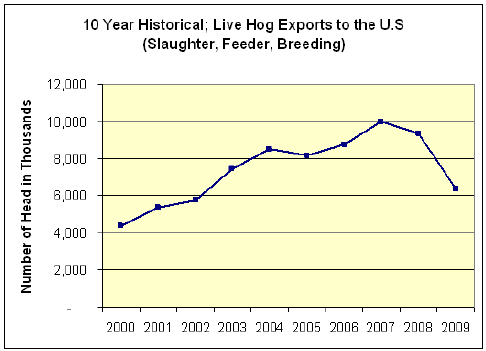


Pork Imports
Canadian pork imports totaled 180,260 mt in 2009, up about 10,000 mt from the earlier estimate and down slightly from the 2008 record high of 194,541 mt. Total imports are forecast at 210,000 mt, up 10,000 mt and in line with a rebound in consumption as Canadian consumers continue to seek out value prices for protein.

Pork Exports
Pork exports fell slightly in 2009 to 1.12 mmt as the drop in exports to Russia were almost completely offset by gains in sales to the United States and Taiwan. For 2010 the export forecast is raised slightly to 1.13 mmt reflecting the reopening of the Chinese market as well as overall expectations that world wide pork consumption will trend upward as recessionary pressures soften and consumers look for lower priced meats. After significant fluctuations and a marked rise in 2009, the value of the Canadian dollar has been relatively stable, at a higher level, in the last few months. This stronger Canadian dollar is a drag on export potential and any further strengthening could hurt overall export competitiveness in 2010.
Policy
Canadian Hog Buyout Programme Launched
Despite the 2008 programme to reduce the breeding herd, producers appealed to the government for additional assistance arguing that returns to the swine industry were further hampered by the strengthening of the Canadian dollar, high feed prices, reduced consumer demand due to the mislabeling of the H1N1 virus as Swine Flu, and the US Country of Origin Labeling laws. In mid-August, 2009 the Minister of Agriculture’s announced a new suite of three programmes totaling C$92 million. The details became available in early December. The C$75 million Hog Farm Transition programme (HFTP) assists farmers who see no viable alternative but to cease hog production for three years. HFTP provides funding through a process of four tenders, the last of which requires bid submission no later than 10 March 2010. Just under C$14 million remains of total funds available. The aim of the programme was to reduce the herd by the equivalent of 250,000 sows. The following table summarizes the results of the first three tenders. Because of the timing of the programme (retroactive to 1 April 2009), some of the liquidated animals would have already been removed by the inventory numbers for 1 January 2010. The total reported for the first three tranches represents about 2.3 per cent of the 2009 total pig crop/production. The highest proportional reductions are in the small producing provinces of British Columbia and the Atlantic region. The largest reduction, Ontario, represents about 3.6 per cent of the provinces total 2009 production.
The second tool made available is the Hog Industry Loan Loss Reserve Programme (HILLRP) is a loan guarantee programme that assists producers who wish to continue in hog production address their liquidity problems. Producers applying for the loan must demonstrate to lenders that their businesses are or can be viable as well as have a reasonable prospect for loan repayment. The Government of Canada will share loan loss risk with the commercial lenders. The loan terms will be negotiated between lenders and applicants and shall not exceed 15 years. Maximum loan amounts will be passed on number of animals produced in past year or tax year at rates of C$85 per market hog, C$30 per weaner and C$25 per iso weaner. Producers cannot receive benefits from both the HILLRP and the HFTP programmes. On 24 February 2010, citing request from producers who need more time to develop business plans, the deadline for this programme was extended from 1 March to 26 March 2010.
The third part of the plan is the C$17 million International Pork Marketing Fund (IPMF) to bolster market development in critical markets and fund activities to capture greater value from export markets. In addition, the fund allocates resources towards resolving trade restrictions. This programme is being carried out by Canada Pork International, the export promotion arm of the Canadian pork industry.
The new suite of programmes followed the 2008 Cull Breeding Swine Programme. That programme was announced in April 2008 to cover period of 1 November 2007 through 1 November 2008 and later extended to cover period to 1 August 2007. The programme required producers to agree not to house breeding swine in at least one barn for a period of three years from the last cull date. The programme resulted in a reduction of 110,000 breeding swine or about 7.3 per cent of the total. The extension contributed at least 21,000 head to the total and the accounting for the last submissions may further add to the total. The programme was aimed at a 10 per cent reduction.
Agreement Reached to Resume Pork Exports to China
In the spring of 2009 China shut off imports of pork and hogs from countries affected by the H1N1 virus, including Canada. For Canada, pork shipments had reached a height of 23,000 mt in 2008. The Canadian Food Inspection Agency negotiated with their Chinese counterparts and on 25 February 2010 Canada announced that agreement on the wording of a veterinary certificate had been reached. Shipments are expected to resume immediately.
Canada Launches WTO Dispute
In late 2008 Canada and Mexico filed dispute at the World Trade Organization (WTO) on the interim rule of the Country of Origin Labeling (COOL). Consultations were held twice and a new case was filed in May 2009. On 19 November 2009, at the request of Canada and Mexico, the WTO Dispute Settlement Body established a single panel to consider the complaints regarding US mandatory COOL. The process to select panelists is still underway. The substance of Canada and Mexico’s claims remain the same, and include allegations of inconsistency with the General Agreement on Tariffs and Trade 1994 (national treatment and transparency provisions), the Agreement on Technical Barriers to Trade (technical regulations provisions) or in the alternative, the Agreement on the Application of Sanitary and Phytosanitary Measures, and the Agreement on Rules of Origin (Article 2).
Further Reading
| - | You can view the full report by clicking here. |
March 2010


